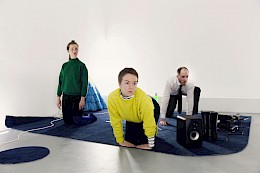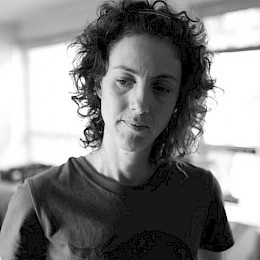1. The exhibition is based on the narrative of a non-human world. This theme defines the context for the artists and visitors as well as for the additional education program. For your project you decided to stage holograms of bookshelves photographed in living rooms. What is your main interest in this topic?
I got the idea when I read about the ancient mythology of Cassandra. Cassandra is the seer that herself isn’t seen. According to Greek mythology her prophecies are ignored by her fellow Trojan citizens because she is cursed by a god whom she refuses to have sex with. As a priest, as a seer, she states that this society will not sustain itself much longer. So she knows about the social crisis that surrounds her – a knowledge that is probably not supernatural given that Troy is besieged by Greek enemy soldiers. As a result, she is not only ignored but even considered a traitor. I think this story speaks a lot about those who still deal with the truth of the current and future social reality and it’s unfolding crisis, how powerless it can feel to analyse and speak about this crisis without being able to directly having an impact on it – just think of the hatred people can face in today’s “post-factual” media world. Allan Sekula once stated: “the old myth that photographs tell the truth has been replaced by the new myth that they lie.” So I decided to stage photographs of bookshelves in a Cassandrian setting. In my view Cassandra’s caves today are living rooms filled with knowledge about the ongoing crisis of the last 3000 years of class society. If humanity will really end in self-extinction one probably would find an answer for how and why this happened in these caves.
2. Where did you find these bookshelves?
In living rooms of people I meet in my everyday life. People I share a conversation with. Then I constructed a framework in which their bookshelves don’t appear isolated but as part of a collective discussion. So maybe I interpret the mythology of Cassandra in a different way than the ancient Greek’s version would suggest. I see her as a realist, rejecting divine authorities, knowing and speaking about a reality in crisis – even though this might not be enough to actually stop the catastrophes from unfolding. In Christa Wolf’s take on this mythology Cassandra’s cave is a communal place of women where she would recover from her priesthood and the physical and mental breakdowns she endured. It’s not a private space but an alternative social model, a place of recovery from the surrounding crisis.
3. One common way to face the crises of our present day world is to explore and establish various strategies of sustainability (e.g. by the use of recyclable materials and energies, the sharing of goods or the collective repairing of things in temporary communities). Do such strategies of sustainability also play a role in your artistic practice?
For me it is very striking to see that up until today the only substantial decrease in carbon emissions is not related to any kind of sustainability policy but to major world economic downturns – like the recent global recession of 2009. So what would happen if our times were no longer dictated by economy? I think this is an interesting question, also for artistic practice. How would an economy of time look like that no longer dominates our lives but instead gives us the necessary space to do what we want? Those bookshelves belong to people that I also share a political discussion with – some of us are currently transforming a former business building into collective dwelling and public working spaces in Frankfurt am Main’s main station area (www.nika.haus) – so yes, communal strategies definitely influence my practice.
4. Given the different problems that characterise our late modern world, on which level do you think could art contribute to social and ecological changes? And is art not always at a high risk to again end up in Cassandra`s role within those processes?
I believe the story of Cassandra as the tragic god-rejecting female priest was invented by those who aimed at legitimising their own divine patriarchal order. With Cassandra’s Cave I stage a different mythology. Maybe Cassandra isn’t really interested in preventing a certain kind of crisis. Every piece of art is a parallel world – and some of these worlds can be quite immersive and tempting and some might actually provoke some thinking or just please the market. These parallel realities are models, simulations, options, images; good or bad is not for the artworks to decide.
5. During the last decade the liaison between art and science has been a topic frequently discussed. In this context art was often considered to be a successful tool for the production of alternative forms of knowledge. How do you evaluate this idea?
In my work, if I deal with science, it is just a resource among other resources. I don’t see the difference between a scientific thesis and, for example, a cookbook.
6. Can you suggest a youtube video that deals with a certain aspect of the exhibition (e.g. the non-human scenario, environmental factors or sustainability)?
These are the dystopian dreams of a future climate-proof gated community, protecting itself from the environment it destroyed and the populations it considers superfluous: https://www.youtube.com/watch?v=HHtyxTWTQrI

